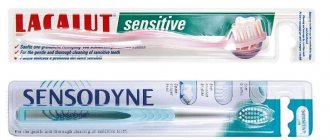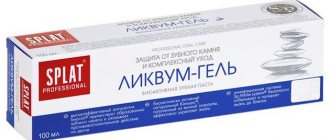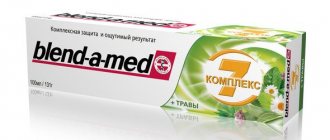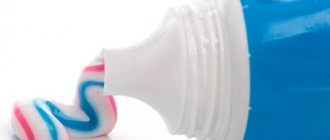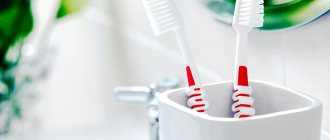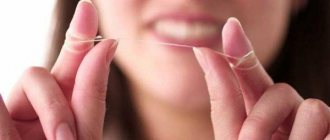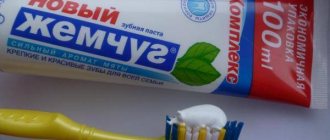Fluoride in toothpaste: benefit or harm?
The war against fluoride in dentistry began in the middle of the last century in the United States. More precisely, this country was the first to begin fluoridating drinking water in order to strengthen the population’s tooth enamel. Then, in 1969, the technique received WHO approval, and many countries around the world began to adopt advanced American experience. Only after a wave of fluorosis (a chronic disease caused by excess fluoride in the body and affecting not only teeth, but also skeletal bones) swept America in the 70s, the feasibility of water fluoridation was called into question. Despite the fact that at the beginning of the 21st century, reputable scientists, including the Australian researcher W. Evans, came out in support of fluoridation, discussions about the benefits of fluoride in medical circles continue to this day.
So is fluoride in toothpaste actually harmful, or are rumors about its negative effects on humans greatly exaggerated? Let's try to dot all the i's in this issue.
Parodontax toothpaste. Which is better, WITH FLUORIDE or WITHOUT?
Good day to everyone who reads my reviews.
I decided to dedicate this review to Parodontax paste , and the main thing is to figure out which paste is better, with or without fluoride.
But first I will tell you my story.
Two years ago, some dark spots began to appear on my upper teeth. At first they were insignificant, then they began to increase little by little. I decided that my teeth just needed to be whitened and was in no hurry to go to the dentist. And in vain. I bought whitening strips, used several, found that there was no effect, and the spots continued to grow. Then I thought about it and started reading information on the Internet. I read about root caries and its consequences, was horrified and immediately ran to the dentist. My worst fears about tooth decay came true. But it was caries at the initial stage, plus the enamel of my teeth was thinned. On top of everything else, for some reason my gums became loose and bled a little. The dentist prescribed me treatment for my gums, sanded the front surface of my teeth and removed these stains as much as possible. And she strongly recommended Parodontax paste with fluoride to strengthen tooth enamel, remineralize it, and prevent gums from crawling.
Now let's try to figure it out.
Fluorine is a chemical element, a gas. In nature, it occurs in the form of compounds with various substances. These compounds are called fluorides. There is a myth that fluoride in toothpaste is dangerous. This myth is based on rumors that fluoride is dangerous to humans even in small concentrations. Such myths work due to the fact that people want to see some kind of mystery in ordinary things and at the same time often judge areas where it is impossible to understand without special knowledge.
I read that at the beginning of the twentieth century, scientists clinically proved that fluoride prevents the occurrence of caries, as well as the proliferation of harmful bacteria in the oral cavity. Therefore, since one thousand nine hundred and forties, in many countries, municipal programs for additional fluoridation of tap water began to develop in order to prevent caries in the population. And then rumors spread about the dangers of fluoride.
It is worth recognizing the fact that in high concentrations, fluorine is really dangerous, like any other trace element in overdoses. But all this does not mean that we need to avoid any ingestion of fluoride into the body, since then we would have to give up green and black tea, apples and other natural products rich in fluoride and beneficial to humans. The main thing is to understand: for fluoride to harm our body, we need to work more than ten to fifteen years in the production of fluorides in violation of safety regulations. It is impossible to obtain a significant dose of fluoride in household doses from food or water, but due to a lack of fluoride, health problems can quite realistically arise.
Indeed, there is such a disease as flurosis, which occurs from an excess of fluoride. There are two varieties of it. Endemic fluorosis almost always develops in the womb or in early childhood before teething. Manifestations of endonemic fluorosis are immediately noticeable - these are uneven white spots on the teeth, which gradually darken and become similar to caries. And the second type of fluorosis is professional systemic fluorosis. It can only occur in workers involved in the production of fluoride when working conditions are violated. It manifests itself in damage to bones and internal organs. But the appearance of the teeth does not change.
Fluorides are simply necessary for teeth: they inhibit the activity of harmful bacteria and prevent their waste products from corroding tooth enamel. Hence the conclusion that fluoride in toothpaste prevents tooth decay. Damaged areas of the tooth are remineralized due to the action of fluorides, therefore, from fluoride, early caries “heals before our eyes.” And we must understand that it is not the fluoride content that is harmful, but its quantity.
Only you can decide which toothpaste to buy, with or without fluoride. You can consult your dentist. I have made my choice. For 2 years in a row I have been buying Parodontax paste with fluoride, sometimes taking a break for something else so as not to become addictive. But then I return to this pasta again. Because it cleans teeth well, solves not one problem, but three at once: protecting teeth from caries, reducing bleeding gums and remineralizing teeth. And now the manufacturer has released it with a new taste, which is now very pleasant and unobtrusive compared to what it was before.
Fluorine and fluorides are not the same thing
Often, opponents of the use of fluorine confuse key concepts: fluorine is a reactive gas that is poisonous to the human body, and fluorides, its octane-based derivatives, are absolutely harmless. Only fluorides (such as sodium fluoride) are used to make toothpaste. Moreover, their concentration in a tube of paste is strictly regulated.
ATTENTION! According to regulations, the permissible concentration of fluoride in toothpaste ranges from 1350 to 1650 ppm. This indicator depends on whether the paste is therapeutic and prophylactic or is intended purely for the prevention of caries (1ppm = 0.0001%).
Fluoride in toothpaste and water are different things
The dangerous disease fluorosis occurs due to the accumulation of fluoride in tissues if it enters the body with water. According to GOST, the fluorine content in water can vary from 0.5 to 1 milligram per liter, depending on the geographic region. It is physically impossible to be poisoned by fluoride through toothpaste, since fluoride is not absorbed in the oral cavity. For this to happen, you need to eat fluoride toothpaste on a regular basis instead of using it for its intended purpose.
Will the paste help with plaque?
According to recent medical research, toothpastes can be effective against plaque and tartar. Regular use of the right product helps prevent the formation of hard plaque. Moreover, high-quality pastes containing a complex of substances to combat plaque destroy dental plaque several times better than single-component products.
An excellent way to combat plaque is ASEPTA SENSITIVE ® Gentle Whitening toothpaste. Enamel whitening occurs through a multi-stage cleansing system, which includes enzymatic components to break down and remove plaque from the surface of the teeth without the use of aggressive acids, abrasives and peroxides that damage the enamel.
The fine abrasives included in this product (RDA 80) remove plaque without leaving microcracks on the enamel. And the combination of “hydroxyapatite and potassium citrate” in the toothpaste prevents the occurrence of increased tooth sensitivity.
An excellent addition in the fight for white teeth will also be the ASEPTA FRESH rinse, a product for daily oral hygiene with a unique combination of xylitol and potassium citrate, which reduces the increased sensitivity of teeth and protects the enamel from the harmful effects of acids and bacteria, and therefore preserves it white and beautiful.
In case of increased tooth sensitivity, ASEPTA SENSITIVE® will perfectly cope with plaque. A paste with a low degree of abrasiveness (RDA 60) allows for oral hygiene without irritating sensitive gums. This product contains a combination of 3 desensitizing components - potassium citrate, thermal mud and hydroxyapatite. The product does not disturb the microflora of the oral cavity and can be used on a regular basis.
Fluoride is a real protection against caries
Today, there are dozens of scientific papers proving a positive relationship between the use of fluoride in toothpaste and the remineralization of teeth. It's simple: fluoride ions are not destroyed in an acidic environment, penetrate the structure of tooth enamel and, combining with calcium crystals, prevent its destruction.
Thus, if you are faced with a difficult choice of toothpaste with fluoride, the best solution would be to make it under the guidance of your dentist, who will select a product with the required concentration of the substance, taking into account the condition of your teeth, region of residence and the presence of concomitant diseases.
What is tartar?
Hardened plaque is called tartar or calculus. This stone is a serious danger to the health of your gums and teeth. As a rule, it forms in those places of the teeth that cannot be reached with a brush, for example, between the teeth, next to the molars.
Dentists consider the following factors to be the main reasons for the formation of tartar:
- Poor oral hygiene. Saliva reactions constantly occur in the mouth; bacteria constantly multiply in the cavity and provoke the appearance of plaque. If you do not remove such plaque with toothpaste and a brush, over time it will begin to build up on the enamel and harden.
- Smoking and frequent consumption of tea and coffee are also common causes of plaque and tartar.
Various diseases of the oral cavity and gastrointestinal tract (GIT) often lead to plaque. The problem is also caused by chewing on one side.
Caries and toothpaste without fluoride
The purpose of brushing teeth twice a day is to eliminate the harmful effects on a person's teeth caused by bacteria that cause tooth decay. Is it possible to achieve this by using exclusively fluoride-free toothpastes every day? Most dentists are inclined to believe that this is 100% impossible. However, it is possible to find a compromise: for example, brush your teeth three times a week with fluoride-containing toothpaste, and the rest of the time use alternative methods.
- Get fluoride from food. One of the common misconceptions about fluoride is that, in addition to water, it can only enter the body from special toothpaste. In fact, in order to cover the body’s daily need for this chemical element (and it is 3.5 milligrams for adults and 0.5-2 milligrams for children), it is enough to regularly eat foods naturally rich in fluoride: green tea, seafood , cherries, beans, egg yolk.
- Use natural toothpastes. Let’s make a reservation right away: they can be considered “natural” conditionally. We are talking about pastes, the chemical composition of which, instead of fluorine, includes hydroxyapatite (a synthetic analogue of tooth enamel) and components of plant origin that have an antibacterial effect: mint extract, sea salt, mumiyo and others.
- Take pills... for caries. Yes, they exist and have long been proven to be 90% effective. Medicines are produced on the basis of lactobacilli, which inhibit the proliferation of cariogenic microorganisms, and as a side effect they also normalize the balance of microflora throughout the gastrointestinal tract.
- Only with a competent combination of several methods of prevention, observance of basic oral hygiene (implying the use of rinse, irrigator and floss in addition to toothpaste), as well as regular visits to the dentist for examination, the occurrence of caries can be successfully prevented.
The best anti-inflammatory toothpastes
Anti-inflammatory toothpastes for periodontitis and periodontal disease will give noticeable results if used along with drug therapy. Often such pastes contain serious components that cannot be used on an ongoing basis. If you use them not in courses, but systematically, dysbacteriosis may develop.
BioRepair Plus Parodontgel
Popularity rating:* 4.9
The Italian company BioRepair produces Plus Parodontgel toothpaste. It contains microcrystals of medical hydroxyapatite, similar to natural hydroxyapatite, which is part of bones and teeth. Extracts of witch hazel, calendula, and spirulina have an anti-inflammatory and calming effect. Hyaluronic acid moisturizes sensitive periodontal tissue, prevents inflammation, and stimulates healing.
Biorepair Parodontgel Plus is packaged in 75 ml tubes. The product has a pasty white consistency and a pleasant, not harsh, minty taste. For periodontitis and periodontal disease, the manufacturer recommends squeezing a small pea of paste onto a brush and brushing your teeth with it in a circle. Plus complement this with delicate gum massage. After this, when rinsing, the liquid should be held for 20-30 seconds.
According to reviews, this Italian paste can make periodontal tissue pink and healthy. This product effectively removes blood from your toothbrush, eliminates swelling, and heals wounds. The increased sensitivity of the periodontium disappears after the first few uses. It also gives a pleasant feeling of cleanliness and freshness. Its use in the initial stages of periodontitis will allow you to postpone a trip to the dentist. The only thing that bothers some people is that this paste is quickly used up.
Advantages
- well thought out, multi-component composition;
- does not contain SLS, parabens, titanium dioxide;
- pleasant consistency and taste;
- quickly eliminates hypersensitivity;
- relieves inflammation;
- relieves bleeding.
Flaws
- quickly consumed.
ROCS Gum balm
Popularity rating:* 4.8
The next nominee in the review was the Gum Balm toothpaste from the popular Russian brand ROCS. This product contains a natural anti-inflammatory complex based on medicinal plant extracts. This product does not contain fluoride, antiseptics or synthetic dyes. When using this Balm, you can forget about blood on the toothbrush and inflammation that appears with periodontitis.
ROCS toothpaste has a creamy, thin consistency. It smells pleasantly of mint and is white in color. Its aftertaste is slightly salty. Considering that this product is called a “balm,” to achieve the best effect, you need to spit out the excess paste after the hygiene procedure, but do not rinse your mouth. And then do not eat or drink for another 30-40 minutes.
Consumers share that inflammation during periodontitis begins to subside already on the 3rd day of using this product. Along with this, teeth are perfectly cleaned of plaque, and your breath becomes fresh for a long time. With periodontitis and periodontal disease, it can be just a godsend. This paste can be used on an ongoing basis. It is very economical in use. But for some, due to xylitol, it seems very sweet.
Advantages
- contains a natural anti-inflammatory complex;
- pleasant mint taste and aroma;
- You don’t have to rinse your mouth after using this product;
- quickly relieves inflammation on the gums;
- reduces bleeding;
- one tube lasts a long time.
Flaws
- Too sweet for some due to xylitol.
Dental Clinic 2080 Medicinal herbs and biosalts
Popularity rating:* 4.7
Toothpaste, owned by the Korean brand Aekyung, contains extracts of honeysuckle, dandelion, wormwood, chamomile, thyme, pine oil, biosalt, vitamins E and B. It is designed to maintain healthy and youthful gums. This product is designed to prevent periodontitis and periodontal disease. Can be used by adults and children from 6 years of age.
This toothpaste is sold in a plastic tube. It has a convenient lid that can be removed by squeezing it from the side and closed by snapping it into place. The consistency of the paste resembles a gel. Its color is striped (pearl-honey), its aroma is herbal. Salty notes are immediately felt in the taste. The product is consumed economically. Foaming is average, but this is quite enough for high-quality cleansing.
Consumers respond very well to this Korean toothpaste. They love how this product relieves inflammation associated with periodontitis and periodontal disease. At the same time, the product makes the enamel less sensitive and your breath fresher. During the cleansing process, the product does not burn or burn your lips. But at the same time, not everyone may like the obvious salty aftertaste.
Advantages
- good combination of salts and herbal ingredients;
- inflammation during periodontitis is stopped;
- protects gums from bleeding;
- pleasant taste characteristics of the paste;
- convenient lid on the tube;
- The paste lasts a long time.
Flaws
- Not everyone likes the salty aftertaste.
Revidont with Neovitin
Popularity rating:* 4.6
The Russian company NPTsRIZ produces Revidont toothpaste with Neovitin. This product contains the following active ingredients: birch bark extract “Betulavit”, complex “Activitin” (chamomile, sage, calendula, St. John’s wort), complex “Neovitin” (ginseng biomass). This product is recommended for the effective prevention of periodontitis and periodontal disease, protecting the oral cavity from allergies and candidiasis.
Revidont toothpaste with Neovitin is packaged in soft tubes. Its consistency is creamy. The color of the paste is white, and the taste and aroma is dominated by lemon. The product produces a sufficient amount of foam while brushing your teeth. It is very comfortable to use. The product is used very economically. The enamel does not stain. Revidont with Neovitin specifically affects the tissues surrounding the roots and neck of the tooth.
According to reviews, this Russian toothpaste significantly reduces pain and swelling during periodontitis and periodontal disease, and prevents the appearance of blood during brushing. With the systematic use of Revidont with Neovitin, you can count on preventing the destruction of periodontal tissue. The plant extracts in the composition perfectly relieve inflammation and heal wounds in the mouth. This paste also gently but efficiently removes plaque.
Advantages
- innovative composition;
- pleasant taste characteristics;
- delicate to use;
- economically used;
- quickly stops the inflammatory process;
- excellent prevention of periodontitis.
Flaws
- not identified.
Asepta Parodontal Active
Popularity rating:* 4.5
The Russian pharmaceutical company Vertex produces Asepta Parodontal Active toothpaste. This product contains extracts of sage, calendula and St. John's wort, which have a pronounced antimicrobial effect and quickly relieve inflammation. Other active ingredients include xylitol and the enzyme papain. You can completely forget about inflammation and blood on your toothbrush during periodontitis with this paste.
Asepta Parodontal Active is sold in a laminated tube (75 ml). This paste is creamy in consistency and has a pleasant mint color. The taste smells of lime and mint. It is soft, not scalding, but very refreshing. The manufacturer recommends brushing your teeth with this product for 3 minutes 2 times a day. Asepta Active has average foaming and is used quite economically.
Consumers confirm that with this product it is possible to get rid of severe inflammatory processes and bleeding during periodontitis. Asepta Parodontal Active significantly improves the hygienic condition of the oral cavity. The product rinses out completely and does not leave a soapy aftertaste. But at the same time, some consumers note that after using this paste their enamel becomes more sensitive. Therefore, they do not recommend using it all the time.
Advantages
- good combination of composition components;
- pleasant taste;
- the tube lasts a long time;
- solves the problem of bleeding during periodontitis;
- stops the inflammatory process;
- does not leave a soapy aftertaste.
Flaws
- For some, it causes increased sensitivity of the enamel.
AltaiBio Cedar-fir
Popularity rating:* 4.4
Russian toothpaste AltaiBio Cedar-fir contains 5 plant extracts, menthol, sodium fluoride and colloidal silver concentrate. This product has a pronounced anti-inflammatory effect. It can be used to prevent periodontitis and periodontal disease. AltaiBio Cedar-fir can be used for hygienic manipulations every day.
The toothpaste is packaged in plastic tubes in quantities of 100 g. It is quite dense and does not spread when squeezed onto a brush. Her color is white. The taste is fir with a mint aftertaste and a taste of pine nuts. The aroma is tart, but quite pleasant. The paste foams weakly, but for many this is a plus. The method of use of this remedy for periodontitis is standard.
Many people speak very highly of AltaiBio Cedar-fir toothpaste. They confirm that it eliminates bleeding during brushing and perfectly eliminates the inflammatory process and pain associated with periodontitis. Makes periodontal tissue more dense. In order to prevent periodontitis and periodontal disease, many people choose this particular product. But some are confused by the fact that, along with very useful active ingredients, this paste contains parabens.
Advantages
- a good set of active components;
- pleasant texture, taste and aroma;
- periodontal tissues stop bleeding;
- heals minor injuries in the oral cavity;
- eliminates the inflammatory process.
Flaws
- contains parabens.
Forewarned is forearmed!
Let's summarize: the harm to human health from using toothpaste with fluoride today cannot be considered a scientifically proven fact. Research in this direction is carried out regularly around the world, and its results can be found from open sources. It’s up to you to decide which product to choose for daily oral care for yourself and your loved ones. But when making such a serious choice, remember two important nuances.
- Fluoride is poison, and fluoride is medicine.
- Excess fluoride leads to fluorosis, while its deficiency makes the way for caries easier.
